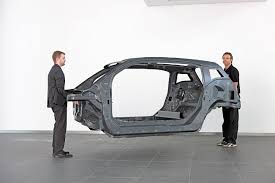
For over a hundred years cars were made of mild steel and oxy-acetylene gas welding was our friend. No longer. In the never ending search for light-weight stronger design, we’ve seen a range of high-tensile steels, alloys, plastics and aluminium components. Carbon-fibre has now arrived.
This image shows the body shell of a BMW1 electric car, it’s stronger and lighter than the guy lifting it. Other manufacturers have been using carbon-fibre for external panel for some time including Volvo and Mercedes. Cost is the only construction impediment but that trivial fact wasn’t a show-stopper for the Aston Martin DBS, at least half of the car is carbon-fibre or carton-ceramic.
It’s predicted that by 2020 there will be a huge uptake in carbon-fibre construction in ordinary commuter cars, and this will have enormous implications for the collision repair industry. At best it will be labour intensive, highly complex, and require significant investment in specialised equipment. This will be highly advanced repair technology – rocket-science by panelbeaters. Drive your Aston Martin carefully until we’re sure how it’s done!


Robert Jones
Carbon fibre is not new it’s been used in Formula1 cars for years and easy to fix because the impact damage caused by collision is localised so no different to working with fibreglass. Same stuff really.
Ken Black
Agree carbon fibre does not distort but it is NOT the same as fibreglass and repairing it won’t be that simple. It is very futuristic and just another challenge for panelbeaters problem is we’re still being paid the same rate as when we were repairing 1980’s technology cars.